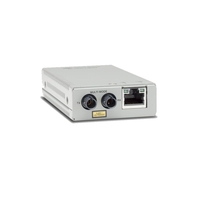-
Home
-
Contributors
-
International
-
Account
-
Information
More From Contributor
- Bullyl&. Bullyland has been manufacturing for 30 years & make products that encourage imaginative play. ...
Allied Telisis TAA 10/100TX To 100X/ST SMODE Mini Media+ Rate
Converter 10KM IN
LC or SFP connectors capable of multi-mode or single-mode fiber connectivity. The twisted-pair copper port has an RJ-45 connector supporting either 100Mbps or 1000Mbps, with a maximum operating distance of 100 meters (328 feet). Smart Link restoration allows the devices, in cases of power failure, link loss or other interrupted service, to automatically restore the link without the need to restart/reset them. The MMC Series continues the Allied Telesis commitment to the environment with over 50% power savings.* With just 1.7W of power usage, the MMC Series media converters are some of the most efficient in the market today. Many new backbone switch products now support the industry-standard IEEE 802.1Q specification for Virtual LANs (VLANs) that send extra-long data packets on the
network. The MMC Series are fully compatible with these long packets, enabling them to be used in modern networks. Media converters not supporting this feature discard these extra long packets, making them unsuitable for modern networks. The link test is a fast and easy way for you to test the connections between the media converter ports and the connected end nodes. If a network problem occurs, you can perform a link test to determine which port is experiencing a problem, and focus your troubleshooting efforts on the right cable or end node.
- Availability: In Stock
- Supplier: Ebuyer
- SKU: 992029
Product Description
The Allied Telesis MMC Series of mini media converters leverages its smaller size to not only help the environment with a small carbon footprint, but also to save space in its working environment. Despite its compact size, the MMC Series delivers all the power & functionality of standard size media converters. The smaller size & external power supply of the MMC Series allows them to be used almost anywhere. The Smart Missing Link™ (SML) feature monitors network connections & provides notification when network segments fail, allowing network managers to quickly identify the source & location of failed segments & minimize downtime. The MMC Series are available in 100 Mbps or 1000 Mbps models. Depending on the model chosen, the fiber-optic port has options for fixed SC, ST, LC or SFP connectors capable of multi-mode or single-mode fiber connectivity. The twisted-pair copper port has an RJ-45 connector supporting either 100 Mbps or 1000 Mbps, with a maximum operating distance of 100 meters (328 feet). Smart Link restoration allows the devices, in cases of power failure, link loss or other interrupted service, to automatically restore the link without the need to restart/reset them. The MMC Series continues the Allied Telesis commitment to the environment with over 50% power savings.* With just 1.7W of power usage, the MMC Series media converters are some of the most efficient in the market today. Many new backbone switch products now support the industry-standard IEEE 802.1Q
Specification for Virtual LANs (VLANs) that send extra-long data packets on the network. The MMC Series are fully compatible with these long packets, enabling them to be used in modern networks. Media converters not supporting this feature discard these extra long packets, making them unsuitable for modern networks. The link test is a fast & easy way for you to test the connections between the media converter ports & the connected end nodes. If a network problem occurs, you can perform a link test to determine which port is experiencing a problem, & focus your troubleshooting efforts on the right cable or end node.
Reviews/Comments
Add New
Intelligent Comparison
We couldn't find anything!
Perhaps this product's unique.... Or perhaps we are still looking for comparisons!
Click to bump this page and we'll hurry up.
Price History
Vouchers
Do you know a voucher code for this product or supplier? Add it to Insights for others to use.


 United Kingdom
United Kingdom
 France
France
 Germany
Germany
 Netherlands
Netherlands
 Sweden
Sweden
 USA
USA
 Italy
Italy
 Spain
Spain













 Denmark
Denmark